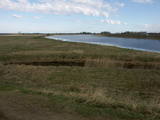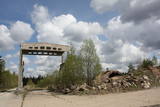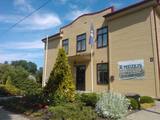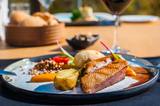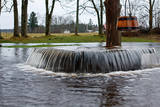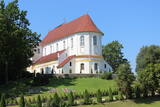| Нo | Название | Описание |
|---|---|---|
|
One of the most important locations for migrating water birds in terms of rest and feeding in Latvia is the Svēte flood-land, which overflows in the spring time, along with the Svēte polder. It has been calculated that when circumstances are good, tens of thousands of birds can be seen in the area – swans, geese, corn-crakes, pintails, predatory birds, plover-type birds, etc. |
||
|
Ремонтные мастерские кораблей и береговой ракетной обороны в Бартских лесах в Книпупьи Лиепайского района, действительно, визуально являются довольно впечатляющим военным объектом бывшего СССР. В настоящее время территория находится в управлении края, здания демонтированы с целью получения строительных материалов.
|
||
|
The park was founded by the gardener Arvīds Janitens. Professor Raimonds Cinovskis has said that Arvīds is just amazing, because he alone did work that would usually be done by a big group of people. This is one of the most popular tourism destinations of its kind in Latvia.
|
||
|
Хутор Elkas kalna saimniecība расположен на вершине живописной горы Элкас ‒ в том месте, где начинается Гауя. Травяные чаи, разные виды березового сока, варенье и другие полезные для здоровья лакомства из собранных на местных лугах и выращенных в саду растений. Также предлагаются природные мастерские и пикники под открытым небом. |
||
|
Один из главных остановочных пунктов на Северокурземском побережье, где можно получить обширную информацию и представление об истории края и побережья, культурно-исторических ценностях, строительстве парусников, традициях рыболовства, людях этого края, их труде и заслугах. Музей в Рое был основан в 1968-м году. В настоящее время можно осмотреть постоянные экспозиции о Кришьяне Валдемаре, мореходной школе в Рое и строительстве парусников в 19-м веке. Создана также экспозиция об истории рыбообработки с 19-го века до наших дней, Ливском береге, о советском вкладе в развитие побережья. Кроме осмотра основной экспозиции еще можно «познакомиться» с тремя жительницами Курземе, представляющих различные исторические периоды: Милдочка – простая жена рыбака c побережья, госпожа Паулиня со времен парусников и Анна Петровна с советского времени. Они увлекательно знакомят с предметами, не представленными в музее и со «скверным» юмором жителей Курземе. (Источник: Ройский ТИЦ) |
||
|
Аркада Лиела Эллите – песчаное образование со множеством арок, столпов и ниш. Общая протяженность пещеры Лиела Эллите (Эллите, Велна цеплис, Велна краснс, Велла ала, Лиепмуйжас ала, Лиепас ала) составляет более 20 метров, высота сводов достигает 3,5 метра, а ширина – 5 метров. Из пещеры вытекает мощный источник. Предполагают, что пещера начала образовываться уже 7000 лет назад. Пещера много раз подвергалась разрушению, в начале 20-го века в ней добывали белый песок. Пещера является древним культовым местом. В наши дни место благоустроено. |
||
|
В винном погребе Murimäe предлагается вино из лучшего эстонского винограда. Хозяйство занимается производством виноградного, ягодного и фруктового вина, здесь также проводятся дегустации и курсы. |
||
|
В месте, где правый основной берег древней долины Гауи раскалывают несколько глубоких оврагов с маленькими ручьями, расположился Турайдский музей-заповедник с выдающимися в масштабе Балтии памятниками, история которых уходит в 1000-летнее далекое прошлое. Среди них необходимо упомянуть Турайдскую господскую усадьбу (21 здание), могилу Турайдской Розы, Турайдскую лютеранскую церковь (одна из старейших (1750 г.) деревянных церквей Латвии) и Турайдский замок. Рядом на горе Дайн организуются всевозможные тематические мероприятия. |
||
|
The tower is in the western part of the Vasenieki swamp, and an interesting nature trail with information stands and pathways was recently established there. The tower offers a look at unique swampland – visitors can survey the entire swamp. Wear proper footwear when it is damp outside!
|
||
|
Pilsētā nebija lielu rūpniecības uzņēmumu, un tās iedzīvotāji
nodarbojās galvenokārt ar amatniecību, tirdzniecību un lauksaimniecību.
Ilūkste tika pilnībā nopostīta 1. pasaules kara laikā un smagi cieta arī
2. pasaules kara laikā. Šodien Ilūkste ir klusa pierobežas mazpilsēta, ko
ieskauj gleznains dabas apvidus. Apskates objekti: bijušā jezuītu klostera ēka
un Ilūkstes katoļu baznīca.
|
||
|
Ресторан находится в первой в Латвии пятизвездочной гостинице, расположенной за чертой города, в красивом месте с историей и будущим ‒ в Аматциемсе. При приготовлении блюд повара используют местные, выращенные натуральным способом продукты, и подают их в современной интерпретации, делая акцент на вкусе и качестве. |
||
|
Dvietes un netāli esošais Skuķu ezeri ir vieni no teritorijas grūti pieejamajiem palieņu ezeriem – lielākie šāda tipa
ezeri Latvijā. Palu laikā pārplūst, savienojoties vienā lielā ūdenskrātuvē.
|
||
|
Trīs lielāka izmēra laukakmeņi – aizsargājami dabas pieminekļi, kas atrodas Matsalu līča krastā starp Sāstnas (Saastna) un Metskjulas (Metsküla) ciemiem. Tuvējā ceļa malā ir izvietots informācijas stends un norādes, bet līdz akmeņiem var nokļūt pa iezīmētu taku. Pēc kāda tautas nostāsta, lielas vētras laikā, kas notikusi Jaungada naktī, lielais akmens sašķēlies trīs daļās. No tā arī cēlies vietvārds. Apkārtnē redzamās pļavas ir nozīmīga daudzu augu sugu dzīves vide un svarīga putnu ligzdošanas un atpūtas vieta. Šī iemesla dēļ taku drīkst apmeklēt tikai no 1. jūlija līdz septembra beigām. Akmeņi ir arī labi redzami no minētā ceļa. Tie ar ledāju atceļojuši no Turku (Somija) apkārtnes. |
||
|
Ремесленник, используя методы экспериментальной археологии, изготовляет украшения старинных племен балтов и рассказывает об их символике, значении и традициях ношения. Предлагают осмотр мастерской и приобретение готовых изделий. |
||
|
The road trip from Vilnius to Rīga will take you to the most beautiful and important sightseeing places of the Next on the route is the Dubysa Regional Park, which includes the spectacular Dubysa river valley, historic churches and mounds along its banks. Be prepared, since the terrain of this area is rather rolling. Next, you will visit the town of Šiluva, which is a Catholic pilgrimage site, and then travel to the Tytuvėnai Regional Park, where you walk the natural trail of the lake of Gilius, which is part of the Forest Trail. The tour will continue in the Kurtuvėnai Regional Park, where you will walk one section of the Forest Trail from Kurtuvėnai to Šaukėnai, leading along small forest trails, educational trails, beautiful tree alleys and through wetlands. Then you will go to the region of Samogitia, visiting Telšiai and walk one of the Forest Trail sections along Lake Plateliai. Next, the tour takes you through the stone town of Mosėdis to Latvia, where you will stop over to have a walk on one of the oldest towns in Latvia – Aizpute, enjoying its 19th century wooden architecture and the local wine brewery. Next you will take a small walk along the Forest Trail in the eye-catching Kazdanga manor park and drive on to the most beautiful town of Kurzeme – Kuldīga. At the end of the tour, you will walk a section of the Forest Trail along the Abava River Valley Nature Park and nature trails in the Ķemeri National Park. |
||
|
Уникальный тематический парк на первозданном берегу реки Пирита создан с целью вызвать интерес к могуществу древних викингов. Возможности: крепость викингов, место комланий, кузница, древние единоборства, представления, поездка за сокровищами по реке Пирита на судне викингов, путешествие на лодке-долбленке, камнеметательная машина, стрельба из лука, метание топора, баня-землянка и баня по-черному, ловля форели, приключенческое проживание, питание и т. д. |
||
|
This is a large, outstanding and expressive tree, Latvia’s thickest Norway Maple (Accer platanoides).
|
||
|
Находятся в южной части Скайсткалне, направом берегу долины Мемеле. Церковь(стиль барокко) называют красивейшим храмом католиков в Земгале. К осмотру представлен богатый интерьер, а также гробница священников и дворян. |
||
|
Блюда готовят из латвийских продуктов. Меню меняется в зависимости от сезона, чтобы гости могли насладиться сезонными блюдами. С 360-градусной застекленной террасы открывается живописный вид на сердце Цесиса – площадь Рожу. |
||
|
Atrodas Tirdzniecības kanāla dienvidu krastā, kas padomju laikā bija slēgta zona ar pierobežas režīma statusu. Tagad lieliska pastaigu vieta, kur var vērot kuģīšus un jahtas. Promenādes visā garumā izvietojušies vēsturiskie spīķeri. Šeit meklējami krodziņi, viesnīcas, mūzikas klubs, mākslas galerija un Dzintara pulkstenis. |
||
